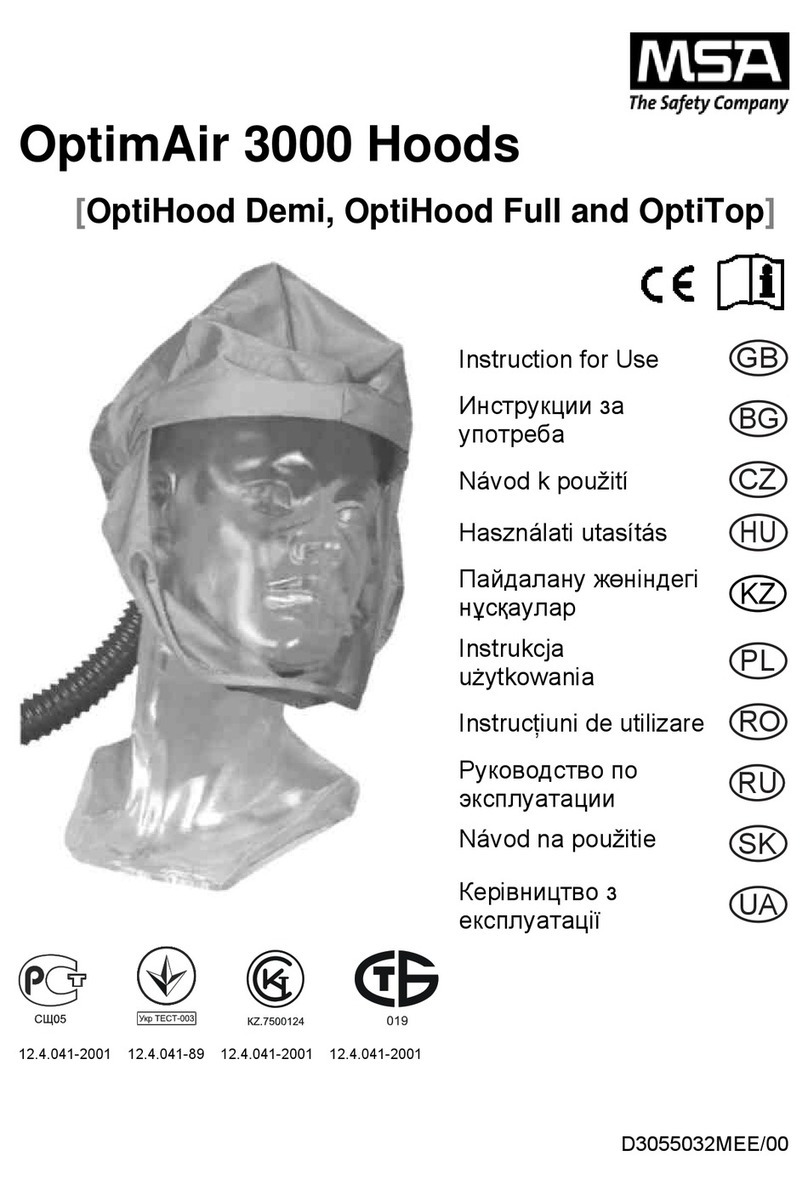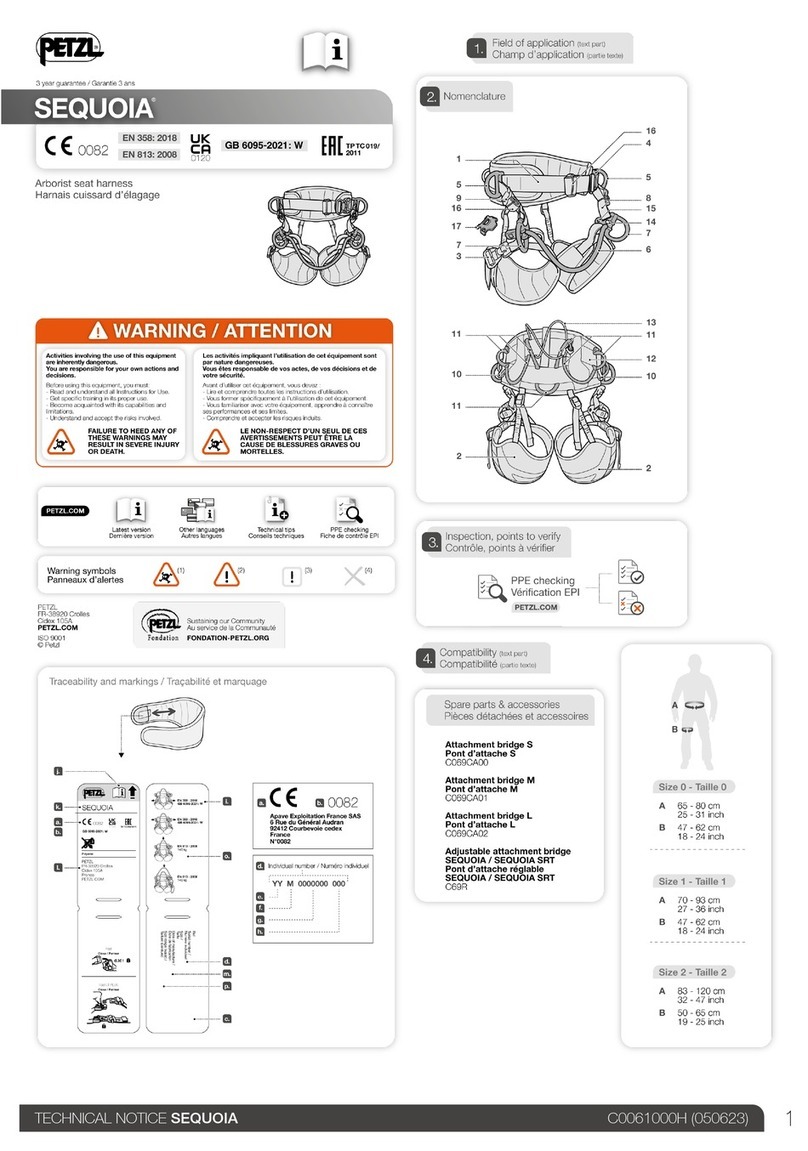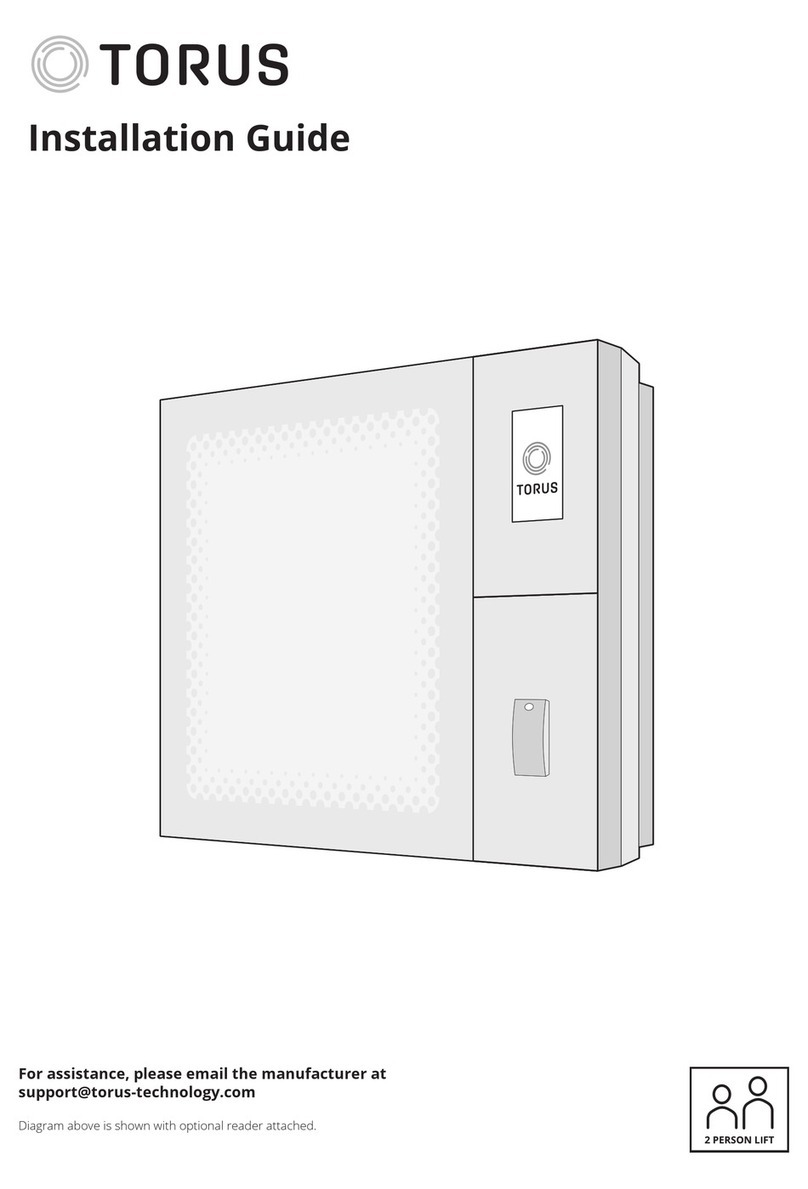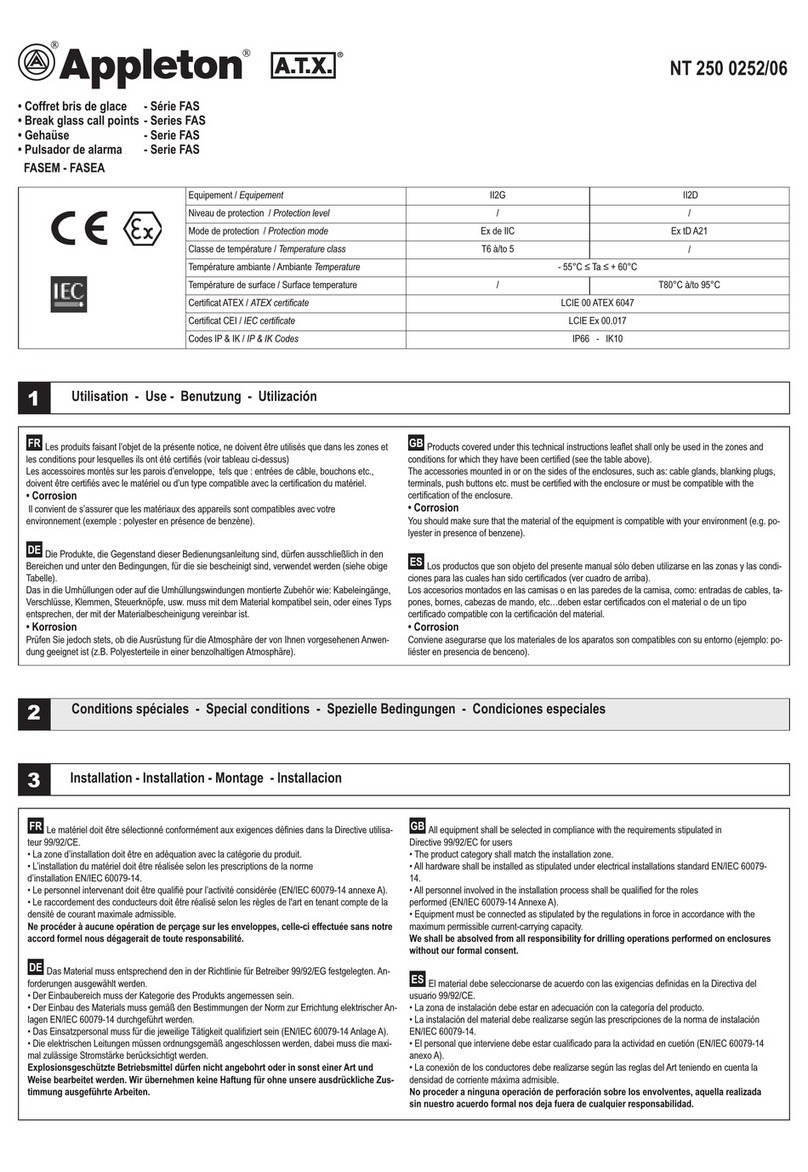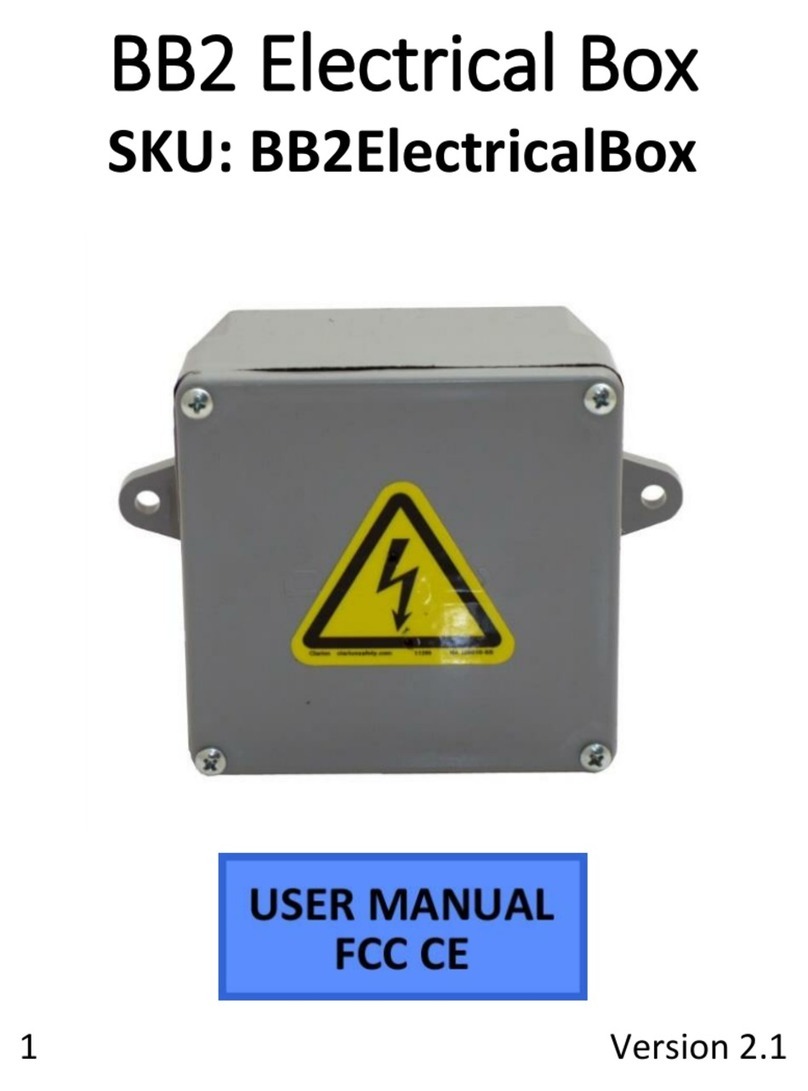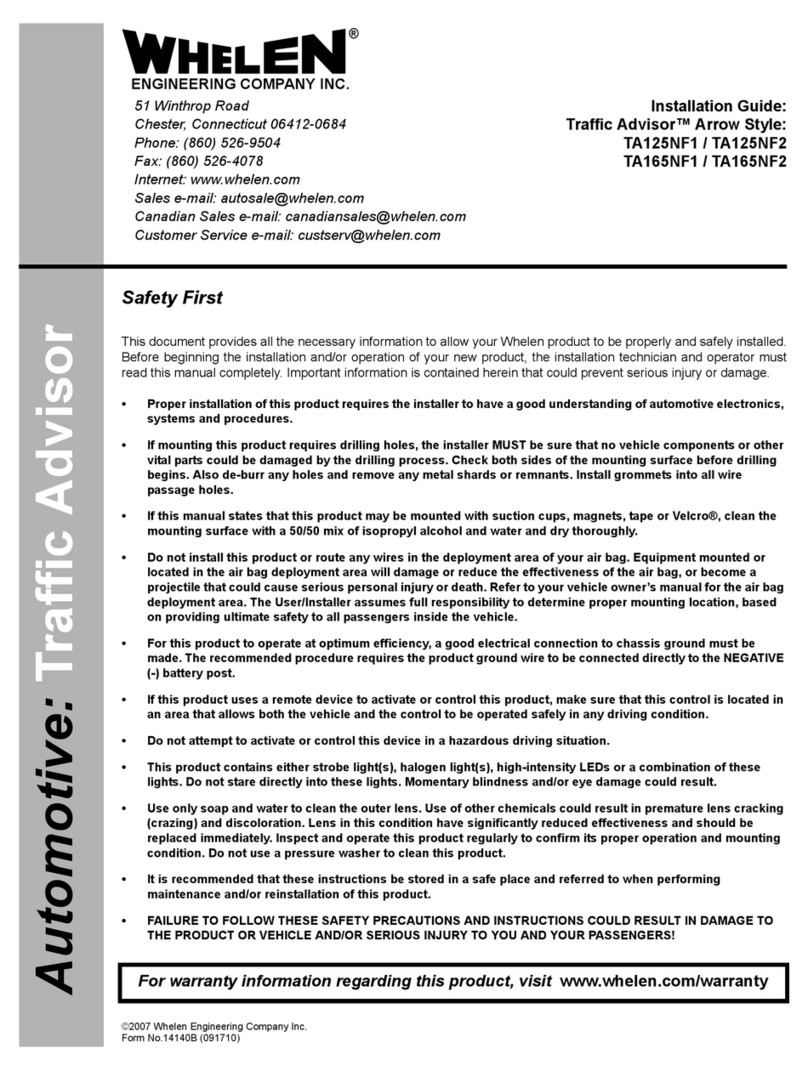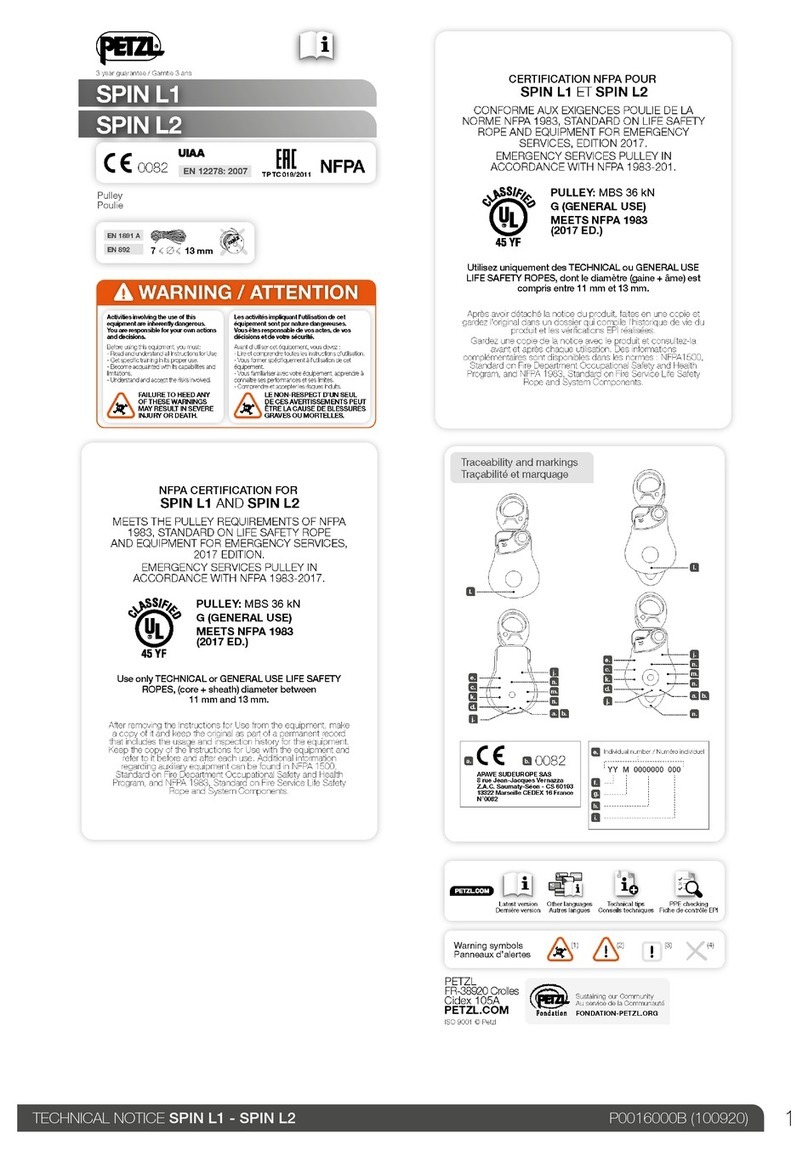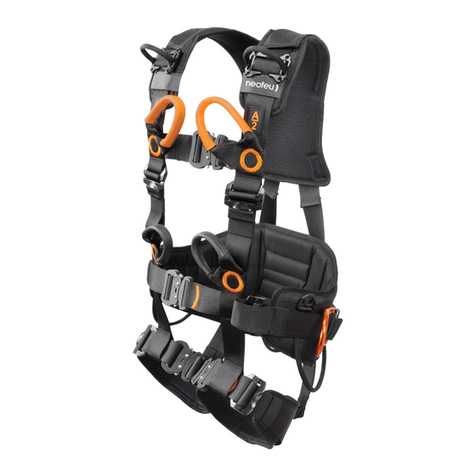Strong Enterprises Para-Cushion L-39 User manual

Para-Cushion
Model L-39
Part Number 124112
with
Strong C-9 Canopy
Part Number: 401010
Revision D
March 2021
L-39 Jet Trainer
Manual P/N 510085
Owner’s Manual
For packing and maintenance of
US Patent 3,908,937

2Strong Enterprises owner’s manual. Para-Cushion
www.strongparachutes.com
! WARNING !
Parachuting is a hazardous activity that can result in serious injury or
death. Failure to follow all warnings, instructions and required procedures
may result in serious injury or death. Parachutes sometimes malfunction,
even when they are properly designed, built, assembled, packed, maintained
and used. The results of such malfunctions are sometimes serious injury
or death. There are so many factors, both human and natural, beyond our
control that we want you to clearly understand that by using or intending
to use our parachutes, you are assuming a considerable risk of personal
injury or death. If you are not willing to assume that risk, please return
the parachute to the dealer where it was purchased for a full refund.
DISCLAIMER
There are NO WARRANTIES which extend beyond the description of the
parachutes in this manual and neither the seller nor any agent of the seller
has made any afrmation of fact or promise with respect to the parachutes
except those that appear therein.
The liability of the seller is limited to the duty to replace defective parts
found upon examination by the manufacturer to be defective in material
or workmanship within 7 days after purchase and found not to have been
caused by any accident, improper use, alteration, tampering, abuse or lack
of care on the part of the purchaser.

3
Strong Enterprises owner’s manual. Para-Cushion
www.strongparachutes.com
Table of Contents
Warning / Disclaimer
Table of Contents 3
1. Introduction 4
1.1. Scope............................................................................................................................................... 4
1.2. FAA Approval................................................................................................................................ 4
1.3. Operational Limitations ................................................................................................................ 4
1.4. Repack Cycle .................................................................................................................................. 4
1.5. Model Description .......................................................................................................................... 4
1.6. System Function............................................................................................................................. 5
1.7. Care of your L-39 Emergency Parachute System ........................................................................ 5
1.8. Service Life ..................................................................................................................................... 6
1.9. Preight Inspection........................................................................................................................ 6
1.10. Fitting the Parachute..................................................................................................................... 6
1.11. Plan Ahead ..................................................................................................................................... 6
1.12. How to get out of the Airplane ...................................................................................................... 7
1.13. How to open the Parachute ........................................................................................................... 7
1.14. How to Steer ................................................................................................................................... 7
1.15. How to Land ................................................................................................................................... 8
1.16. Recovery.......................................................................................................................................... 8
1.17 Reporting Equipment Improvement Recommendations...............................................................9
2. L-39 Product Description 9
2.1. Parts List.......................................................................................................................................10
3. Required Packing Tools 11
4. Prepare Parachute for Packing 12
5. Pre-Packing Inspection 12
6. Packing the L-39 Parachute System 13
6.1. Folding the Parachute....................................................................................................................13
6.2. Stowing the Lines...........................................................................................................................15
6.3. Placing the Parachute into the Container....................................................................................19
6.4. Closing the Flaps of the Container................................................................................................21
6.5 Closing the Container....................................................................................................................23
7. Repair Guidelines 29
8. Changing the Pilot Chute Loop and Cap 30
FAA Approval Letter (Inside Back Cover)

4Strong Enterprises owner’s manual. Para-Cushion
www.strongparachutes.com
1. Introduction
Thank you for purchasing a new Para-Cushion Model L-39 Emergency Parachute System from
Strong Enterprises. It is one of the nest available anywhere and with a little care, should last
you a very long time. Rest assured that your new Para Cushion has been constructed to retain the
durability, reliability and comfort that Strong Enterprises has been building into its products for
over 50 years. We welcome your comments so that we may continue to improve our products and
help make ying safer and more comfortable.
1.1 Scope
This owner’s manual constitutes the manufacturer’s instructions for the operation, packing and
maintenance of the L-39 Emergency Parachute System.
1.2 FAA Approval
Originally certied in 1973 under TSO C-23b, standard category, the Para-Cushion parachute
assemblies were upgraded in 1992 and are now FAA approved under TSO C-23c, (in accordance
with AS 8015A category B and FAR 21, Subpart O).
1.3 Operational Limitations
Limited to use by persons up to 254 lbs (115 kg) fully equipped (person, clothes and equipment), and
up to 150 knots IAS when equipped with the C-9 Parachute Assembly.
1.4 Repack Cycle
Your Para-Cushion model L-39 is designed for a 365-day repack cycle. Your countries laws may
dictate a stricter schedule, check your local regulations. The Para-Cushion model L-39 must be
packed by an FAA certicated parachute rigger, or foreign equivalent, with an appropriate rating
or returned to Strong Enterprises for inspection and repack. If your Para-Cushion is exposed to
moisture, excessive dirt or is damaged it should be inspected sooner than the maximum allowed.
Note!
USA current repack regulations can be found in FAA FAR 91.307
1.5 Model Description
The Para-Cushion series of Emergency Parachutes, including the L-39 Emergency Parachute
System, is an FAA approved emergency parachute system tted with a round, steerable canopy. The
Para-Cushion model L-39 has been designed exclusively for use in the L-39 Jet Trainer. The system
replaces the original Czech Parachute Seat Harness. The unique arrangement of each Para-Cushion
system, with its externally mounted pilot chute (U.S. Patent #3,908,937) allows for a soft exible
container with protected ripcord pins.
! WARNING !
This Parachute System must be installed
by a trained and appropriately rated Aircraft Mechanic.

5
Strong Enterprises owner’s manual. Para-Cushion
www.strongparachutes.com
1.6 System Function
The L-39 Emergency Parachute System is released from the seat by pulling the handle located at
the bottom right hand side of the seat. This releases the locking mechanisms keeping the parachute
securely in place allowing you to exit the aircraft.
! WARNING !
A complete and proper course of training on L-39
emergency procedures from a trained, properly rated
professional is required before using this system.
The Para-Cushion is activated by pulling the ripcord handle. This action withdraws the ripcord pins
and releases the locking loops allowing the pilot chute to eject, catch air and extract the parachute
canopy from the container. The balance of the lines are stowed inside the container. On deployment,
the canopy and suspension lines are extracted from the container.
Once clear of the aircraft, activate the Parachute System by pulling the ripcord handle. This should
be done whether the included static line is installed or not.
Typically, it takes about 2 to 3 seconds from ripcord pull to fully inated canopy, traveling a vertical
distance of 150 to 300 feet. This does NOT mean that you should plan on jumping or pulling at 300
feet. Deployment time and distance depend on many factors including airspeed.
1.7 Care of Your L-39 Emergency Parachute System
Observe these precautions to maximize the service life of your Para-Cushion Emergency Parachute
System. Parachutes are simultaneously very rugged and quite delicate. They are life saving devices
and should be treated with great care. Parachutes are made of nylon, a very strong and durable, but
not invincible, material. Nylon is deteriorated by small amounts of acid and weakened by ultraviolet
sunlight. These surface effects do not seriously inuence thicker materials, such as webbing or pack
material, but canopy cloth is very vulnerable. If your Para-Cushion is opened or used, it should be
brought to an appropriately certied parachute rigger, or returned to the manufacturer for airing,
drying, inspection and repack. FAA FAR 65.129 requires that no parachute be packed, maintained,
or altered in any manner that deviates from procedures approved by the manufacturer.
The parachute should be left unopened inside its protective container ready for use. When you take
your Para-Cushion to your rigger for servicing, they will be glad to allow you to pull the ripcord
yourself, give you a functional demonstration, and answer all your questions. We urge you NOT
to open your parachute in the eld for demonstration purposes. Foreign objects can cause costly
damage to the canopy.
When your Para-Cushion is in the aircraft, care must be exercised to ensure that it is not damaged.
Be sure that it does not come in contact with any sharp or loose metal surfaces, or any objects within
the plane, which might cut or snag it. All metal edges, exposed nuts and bolts, etc. should be taped
or covered to prevent wear on the parachute container. Be sure that your parachute does not come
in contact with water, oils, acids, grease, dirt, agricultural or re retardant chemicals. When not in
use, store your Para-Cushion in its carrying bag in a clean, dry, protected area. If in doubt as to its
condition, consult your nearest parachute rigger or Strong Enterprises.

6Strong Enterprises owner’s manual. Para-Cushion
www.strongparachutes.com
1.8 Service Life
FAA FAR 65.129 requires that “No certicated parachute rigger may pack a parachute that is not
safe for emergency use”. The continued airworthiness of an assembly is at the discretion of the FAA
licensed parachute rigger’s inspection during re-pack. While proper care can no doubt extend its
usefulness, an older parachute should be examined more closely for signs of deterioration. Your
parachute is a sensitive piece of life saving equipment and should be treated as such. However, it
should not be expected to last forever, even with proper care.
1.9 Preight Inspection
The parachute must be inspected by the wearer prior to each use. Check it visually for any unsafe
condition. Be sure the harness is not twisted or misrouted. Be sure the ttings are not rusted. Be
sure the ripcord handle is securely in its pocket (under the fabric pocket covering). Lift the Velcro
on the back pad and check the ripcord pins. Be sure they are properly seated in their loops. All
pins should extend at least 1/2-inch beyond the fabric locking loop. Be sure the rigger’s seal and
thread are still intact around the last pin. That’s your assurance it has not been opened since it left
the rigger’s packing table. Check the packing data card in the nearby pocket to be sure that the
parachute is current and has been repacked in accordance with regulations.
1.10 Fitting the Parachute Harness
The parachute system designed for the L-39 is unique to the aircraft it is installed in and once
installed is locked in position. Therefore to wear the parachute, you must climb into it while it is
installed on the seat. If you are putting the parachute on for the rst time; unsnap the straps, and
loosen all adjustment points. Sit down and slip your arms through the main lift web (the vertical
straps in front), much like putting on a jacket. Next, reach between your legs, pick up each leg strap,
untwist them if necessary, and snap them in place on each side of the lower portion of the main lift
webs (Right strap snaps into the right side hardware). Pull the leg strap webbing below your hips,
tightening them snugly yet comfortably around your thighs Next adjust the vertical straps, one on
each side located below the ripcord handle, and pull upward until the straps are snug. Adjust the
horizontal straps, the ones behind your lower back, and nally snap the belly-band, and the chest
strap hardware, and adjust. Fold and stow all loose webbing ends in the elastic keepers. Be sure the
ripcord handle is accessible. Resist the urge to excessively tighten the harness. This could restrict
your escape from the cockpit.
1.11 Plan Ahead
Be prepared in the event of an emergency situation. Know and rehearse your emergency
procedures before they are needed. With the parachute on, sit in your cockpit and fasten your lap
and shoulder belts. Be certain these are over your parachute harness. Wear gloves, helmet and
goggles, even headphones if you normally use them. Mentally organize your bailout procedure.
Inspect your cockpit for projections or sharp edges that may damage the parachute, or injure you.
Consider canopy ejection, oxygen disconnect, or other requirements that you may be faced with.
All these things take time, and an emergency leaves you little time for errors. Generally, you are
better off staying with the aircraft if it is controllable. However, your margin of safety is reduced
as time passes evaluating your situation. With time many situations can get worse. Make your
decision quickly because all these actions consume altitude.

7
Strong Enterprises owner’s manual. Para-Cushion
www.strongparachutes.com
1.12 How to Get Out of the Airplane
There are only two steps to remember when you must leave your aircraft. 1) Get clear of the
aircraft, 2) then pull your ripcord, in that order. If the parachute begins to open while you’re still
aboard, the wind may inate it, dragging you out or into the tail. Also, it may entangle with the
aircraft. There are no other rules - the aircraft may be tumbling, spinning, or inverted. Simply
get yourself out any way you can. Clear the aircraft and pull your ripcord immediately. There is
enough oxygen to breath and you’ll be descending into denser air.
1.13 How to Open the Parachute
The ripcord handle is located near the chest strap on the wearer’s left front of the harness. The
key is to:
LOOK at the ripcord handle, rather than fumble or tug on a harness tting. Beneath the fabric
cover, the ripcord handle is held in place by a pocket. Look at it rst because it may have been
dislodged by your exit.
REACH over and grab it with both hands (typically with your right hand and left thumb), and
PULL! This is no time to be gentle!
If the ripcord doesn’t come free on the rst pull, check to make sure it is the handle in your hand,
not some other piece of hardware. Back the handle up to the housing to create slack in the cable,
then punch it out again. The entire cable assembly should come completely out of the housing.
To reduce the pull force, push the handle in the direction that the protective ripcord housing points
- rather than straight out from your chest. The ripcord housing on the Para-Cushion L-39 comes
over your shoulder, so push the handle down toward your feet. By having both hands together on
the handle, you also reduce the chance of the canopy or lines entangling with an extended limb.
Keep your feet together for the same reason. Body position is secondary to pulling.
Remember to LOOK-REACH-PULL.
1.14 How to Steer
The C-9 Military Parachute in your L-39 Parachute System uses a method called a four line release
to give your parachute forward speed making it steerable. Once under canopy you will notice over
your head, on each side, a red loop attached to a series of knots. Securely grasp the loops, one in each
hand, and pull hard until all the knots have been released and the rear four lines of your canopy are
free. Doing this will give you the ability to steer your parachute. Pull down right to turn right, pull
down left to turn left. During a repack operation, ask your rigger to show you this steering assembly,
and explain it further.

8Strong Enterprises owner’s manual. Para-Cushion
www.strongparachutes.com
1.15 Landing and Recovery
Ideally, you want to reduce your landing speed by facing into the wind (or quartering slightly).
Avoid all but very slight turns below 200 feet.
Push your feet and knees tightly together and point your toes slightly so you don’t land on your
heels. The tension caused by keeping your ankles and knees pressed tightly together increases
their individual support, reducing your chance of injury. Keep your elbows in and try to look at
the horizon, not down at the ground. This will give you a better idea of your altitude (much like
looking out the side, rather than over the nose during a landing are).
If the wind keeps your canopy inated after touchdown, you may be dragged. Pull in the lines
closest to the ground to spill some air, and then run around the canopy to collapse it.
In most cases you can maneuver the canopy as necessary to avoid as many obstacles as possible.
In the event of a tree or power line landing, keep your feet together so you don’t straddle a limb
or wire. Be prepared to slide through and hit the ground afterwards. You should be able to avoid
power lines, but if not, throw away the ripcord -- it is an electrical conductor. If suspended from a
power line, do not attempt to climb down and do not accept assistance from anyone until the power
has been shut off.
To prepare for a water landing, the chest strap may be unfastened (except with the Aerobatic
harness) as long as you cross your arms in front of the harness to prevent falling out. Depth
perception over water is difcult, so do not attempt to leave your harness above the water. Take
a deep breath just before you splash down. Once under water, unfasten your harness straps and
swim as far as possible upstream, allowing the canopy to blow away from you. Entanglements with
wet nylon cloth and lines can weigh you down.
1.17 Reporting of Equipment Improvement Recommendations
In our effort to continuously improve our products, processes, and services, we invite you to send us
your comments and suggestions. As a user of this equipment, you are uniquely suited to provide us
with valuable feedback regarding design and/or performance. Feel free to tell us what you like and
what you don’t like. Send us an email or mail a letter to:
Strong Enterprises
6448 Pinecastle Blvd. Ste. 104
Orlando, FL 32809

9
Strong Enterprises owner’s manual. Para-Cushion
www.strongparachutes.com
2. L-39 Product Description
This system is designed specically for use in the L-39 and L-29 Trainer Jets. This design incorporates
the Russian designed Parachute Harness / Pilot Restraint system found on the original parachute
assembly. As designed, this system perfectly replaces the original equipment while providing the
pilot with absolute comfort found on the Strong Enterprises entire line of Para-Cushions.

10 Strong Enterprises owner’s manual. Para-Cushion
www.strongparachutes.com
Harness and Container Assembly
124114
2.1 Parts List
26-foot C-9 Canopy
401010
Ripcord Assembly
611406
Pilot Chute, Lil Grabber
790121
Locking Loop
861044
Cap for Pilot Chute
799030
Carrying Bag
816007
Owner’s Manual
510085
Static Line
16 ft length, 5/8 tubular
780530
G-Pad Back Cushion with
Sheepskin padding
812114

11
Strong Enterprises owner’s manual. Para-Cushion
www.strongparachutes.com
3. Required Packing Tools
A - Shot Bags at least 4 each
B - Line Separator 1 each
C - Pilot Chute Locking Rod 1 each
D - Pilot Chute Locking Strap 1 each
E - T-handles 3 each
F - Pull-Up Cords 3 each
G - Flat Head Screwdriver 1 each
H - Tension Plate 1 each
I - Tension Hook 1 each
A
B
C
D
E
F
G
H
I

12 Strong Enterprises owner’s manual. Para-Cushion
www.strongparachutes.com
4. Prepare Parachute Assembly for Packing
1. Gather the appropriate tools.
2. Always count your tools to ensure you don’t leave any in the packed parachute.
3. Lay the harness, container and canopy down on the table with the harness facing down.
4. Attach canopy apex to tension hook and attach container to tension plate. By tightening both
ends canopy will be stretched out, allowing easier inspection and packing.
5. Pre-Packing Inspection
Always perform the following inspection prior to packing:
•Inspect the entire assembly for completeness and any damage.
•Inspect Pilot Chute and bridle.
•Check that the larks-head knot on the pilot chute is secure.
•Inspect Apex area.
•Check entire canopy for damage.
•Inspect lines for damage.
•Check line sequence and 4 line release system.
•Check that the screws are tight in the L-Bars.
•Inspect Harness and Container Assembly.
•Check that the elastic stow bands are in good condition.
•Check tackings for tightness and condition.
•Inspect Hardware for functionality and condition.
•Inspect Harness for nicks, abrasions and sun damage.
•Check ripcord is snug in pocket.
•Check locking loop length. Loop should be 10 inches.

13
Strong Enterprises owner’s manual. Para-Cushion
www.strongparachutes.com
6.1.1
Lay harness, container and canopy
down on the table with the wearer
side facing down. Inspect entire
assembly for completeness and any
damage. Check line sequence and 4
line release system. Flake canopy
and pleat in the normal manner
with an equal number of gores to
each side.
6.1.2
Fold skirt up 90º on each side
parallel to the radial seams.
6. Packing the L-39 Emergency Parachute System
6.1 Folding the Parachute

14 Strong Enterprises owner’s manual. Para-Cushion
www.strongparachutes.com
6.1.3
Fold the canopy into thirds by
bringing the sides up to the middle.
First right side and then left.
6.1.4
Long fold the canopy into fths,
long and tight, bringing the right
side just past center then folding
the left side over center.

15
Strong Enterprises owner’s manual. Para-Cushion
www.strongparachutes.com
6.2 Stowing the Lines
6.2.1
Release tension from the assembly
and prepare container to begin
stowing lines by laying the risers
in the pack tray
6.2.2
Lay risers under riser covers and
close with Velcro© provided.

16 Strong Enterprises owner’s manual. Para-Cushion
www.strongparachutes.com
6.2.3
Keeping lines straight and
untwisted; make your rst stow
in the top left of the container
extending about 1 1/2 inches past
the stow band.
6.2.4
Extend the lines down the pack tray
making your second stow in the
wearer’s bottom left stow band.

17
Strong Enterprises owner’s manual. Para-Cushion
www.strongparachutes.com
6.2.5
Continue stowing the lines in the
same manner, up then down, until
stow bands on left are complete.
6.2.6
Cross over with the lines to the
other side going in between the 2nd
and 3rd grommets in the container.
Make the rst stow on the right
side bottom inboard stow band as
shown in the picture.

18 Strong Enterprises owner’s manual. Para-Cushion
www.strongparachutes.com
6.2.7
Make your second stow in the
inboard top right side as shown in
the picture.
6.2.8
Continue stowing the lines in the
right side of the container up then
down, until all lines are stowed and
you have about 12 to 18 inches of
unstowed line remaining.

19
Strong Enterprises owner’s manual. Para-Cushion
www.strongparachutes.com
6.2.9
Bring a T-handle up through each
of the three grommets in bottom of
container.
6.3.1
Place skirt of the canopy in top
right corner with canopy laying
across top of container. Make a 90°
turn with the canopy and make the
of parachute down the right side.
Place the canopy in position and
extend down to the right bottom
corner of container.
6.3 Placing the Parachute into the Container

20 Strong Enterprises owner’s manual. Para-Cushion
www.strongparachutes.com
6.3.2
About 3/4 of the way up the
container make a 45º fold and bring
canopy over to left side. Canopy
should pass between the bottom
two grommets /T-handles. Allow
the canopy to extend about 5” past
the bottom of the container.
6.3.3
Next fold remaining parachute into
the container up the right side to
the skirt. “S fold” any remaining
canopy up close to, but not on top
of, the skirt.
This manual suits for next models
1
Table of contents








